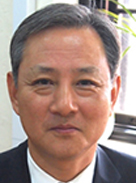 |
정인권(연세대학교)
Dr. Chung is currently a Professor of the Department of Systems Biology in Yonsei University. He received his Ph. D. from Ohio State University in 1991. During his PhD, he studied the reactivity of eukaryotic topoisomerases on various unusual DNA structures including Z-DNA, triplex DNA, and quadruplex DNA. During his postdoctoral training in Harvard Medical School, he worked on double-stranded RNA virus which can infect Leishmania, a parasitic protozoan. He started running an independent research group in the Department of Systems Biology, Yonsei University in 1993. He started working on the structures and functions of human telomere and telomerase, which is a key enzyme complex for continued cell proliferation in stem cells and cancer cells. Although telomerase has been shown to accumulate in Cajal bodies for association with telomeric chromatin, it is unclear where and how the assembly and trafficking of catalytically active telomerase is regulated in the context of nuclear architecture. Dr. Chung and his group identified for the first time MKRN1 as an E3 ubiquitin ligase for telomerase, demonstrating a regulatory role in telomere length homeostasis. His group also elucidated the telomerase RNA biogenesis, holoenzyme assembly, and intracellular trafficking of telomerase and revealed that the catalytically active holoenzyme is assembled in the dense fibrillar component of the nucleolus during S phase. In parallel, the Chung lab has discovered that nuclear speckle is the nuclear site for telomerase recruitment to telomeres. His group is currently dedicated to the study on the regulatory role of chaperones in nuclear transport of telomerase reverse transcriptase.
Representative papers
- Lee JH, Jung M, Hong J, Kim MK, Chung IK. Loss of RNA-binding protein HuR facilitates cellular senescence through posttranscriptional regulation of TIN2 mRNA. (2018) Nucleic Acids Res. 8:4271-4285.
- Hong J, Lee JH, Chung IK. Telomerase activates transcription of cyclin D1 gene through an interaction with NOL1. (2016) J Cell Sci. 129:1566-1579. - G. Lee, Y. Y. Kim, H. Jang, J. S. Han, H. Nahmgoong, Y. J. Park, S. M. Han, C. Cho, S. Lim, J. Noh, W. K. Oh, C. Lee, S. Kim, and J. B. Kim*. SREBP1c-PARP1 axis tunes anti-senescence activity of adipocytes and ameliorates metabolic imbalance in obesity. Cell Metab. 2022 May; 34:702-718.
- Lee JH, Jeong SA, Khadka P, Hong J, Chung IK. Involvement of SRSF11 in cell cycle-specific recruitment of telomerase to telomeres at nuclear speckles. (2015) Nucleic Acids Res. 43:8435-8451
- Her YR, Chung IK. p300-mediated acetylation of TRF2 is required for maintaining functional telomeres. (2013) Nucleic Acids Res. 41:2267-2283.
- Kim JH, Park SM, Kang MR, Oh SY, Lee TH, Muller MT, Chung IK. Ubiquitin ligase MKRN1 modulates telomere length homeostasis through a proteolysis of hTERT. (2005) Genes Dev.19: 776-7781.
|

